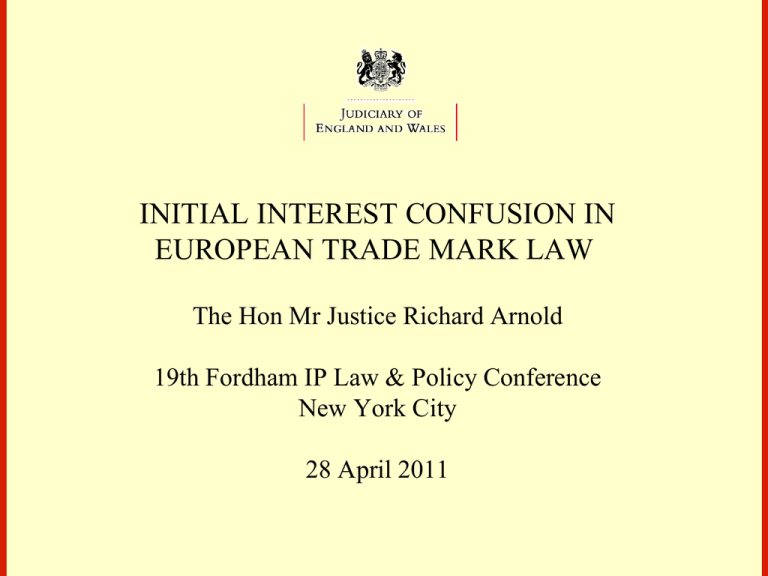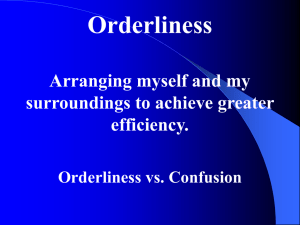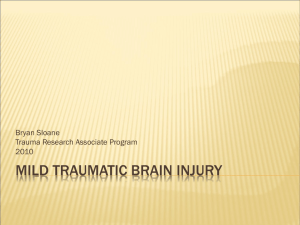Initial Interest Confusion in European Trade Mark Law
advertisement

INITIAL INTEREST CONFUSION IN EUROPEAN TRADE MARK LAW The Hon Mr Justice Richard Arnold 19th Fordham IP Law & Policy Conference New York City 28 April 2011 Initial interest confusion • “Initial interest confusion” may be defined as confusion on the part of the public as to the trade origin of the goods or services in relation to which the impugned sign has been used arising from use of the sign prior to purchase of those goods or services, and in particular confusion arising from use of the sign in advertising or promotional materials. • Prior to the decision in Och-Ziff Management Europe Ltd v Och Capital LLP [2010] EWHC 2599 (Ch), [2011] FSR 11, it had not been clearly decided at least in England and Wales whether initial interest confusion was actionable under Article 5 of the EU Trade Marks Directive. Article 5 of the Trade Marks Directive Article 5 of European Parliament and Council Directive 2008/95/EC of 22 October 2008 to approximate the laws of the Member States relating to trade marks (codified version) includes the following provisions: “1. The registered trade mark shall confer on the proprietor exclusive rights therein. The proprietor shall be entitled to prevent all third parties not having his consent from using in the course of trade: (a) any sign which is identical with the trade mark in relation to goods or services which are identical with those for which the trade mark is registered; (b) any sign where, because of its identity with, or similarity to, the trade mark and the identity or similarity of goods or services covered by the trade mark and the sign, there exists a likelihood of confusion on the part of the public, which includes the likelihood of association between the sign and the trade mark. 2. Any Member State may also provide that the proprietor shall be entitled to prevent all third parties not having his consent from using in the course of trade any sign which is identical with, or similar to, the trade mark in relation to goods or services which are not similar to those for which the trade mark is registered, where the latter has a reputation in the Member State and where use of that sign without due cause takes unfair advantage of, or is detrimental to, the distinctive character or the repute of the trade mark. 3. The following, inter alia, may be prohibited under paragraphs 1 and 2: (b) offering the goods, or putting them on the market or stocking them for these purposes under that sign, or offering or supplying services thereunder; (d) using the sign on business papers and in advertising.” Earlier United Kingdom case law • In BP Amoco plc v John Kelly Ltd [2002] FSR 5 BP was the proprietor of a registered trade mark for the colour green as applied to the exterior surface of the premises used for the sale of the goods, which was registered for goods which included lubricants and fuels in Class 4. The first defendant adopted a petrol station design which featured the colour green. • The Court of Appeal of Northern Ireland upheld the claim for trade mark infringement. Lord Carswell CJ giving the judgment of the Court said at [44]: “[Counsel for BP] emphasised the point that when a motorist travelling at speed sees a green station, at a distance at which the logo cannot be made out, and starts to make preparations to turn off into the station, he is liable to continue his manoeuvre even though he may descry the logo as he nears the station and appreciate that the petrol on sale is that of the respondents and not of BP. As he put it, the antidote to the bane has not been applied and that is a customer lost. We consider that there is force in this contention. ” • In Whirlpool Corp v Kenwood Ltd [2008] EWHC 1930 (Ch), [2009] RPC 2 Whirlpool was the proprietor of a Community trade mark for a representation of a food mixer. It claimed that Kenwood had infringed the trade mark by marketing a similar design of mixer pursuant to Article 9(1)(b) and (c) of the Community Trade Mark Regulation (equivalent to Article 5(1)(b) and (2 of the Directive)). Geoffrey Hobbs QC sitting as a Deputy High Court Judge dismissed the claim. • Mr Hobbs QC held at [75]: “The concept of ‘using in the course of trade’ is amplified by Art.9(2) in a way that appears to make it sufficient for the purpose of establishing liability under Art.9(1)(b) for there to be ‘a likelihood of confusion on the part of the public’ at any material stage or in relation to any material aspect of the commercialisation of the sign in question. From that I think it follows that ‘bait and switch’ selling can be prevented under Art.9(1)(b) on the basis that the process of buying goods or services should, from selection through to purchase, be free of the distorting effects of confusion. I mention that because Whirlpool's claim under Art.9(1)(b) relied on the proposition that there would be a likelihood of confusion unless and until the branding of the kMix as a KENWOOD product impinged upon the consciousness of interested consumers: the shape and appearance of the kMix would initially tell them it was a ‘KitchenAid’ product and the KENWOOD branding would not tell them otherwise until after they had gone down the road of selection with a view to purchase. It is possible for a claim to succeed on that basis. However, I do not accept that in the present case there will be any initial confusion in the mind of the relevant average consumer.” Earlier European case law • In Case C-533/06 O2 Holdings Ltd v Hutchison 3G Ltd [2008] ECR I4231 the Court of Justice held at [36]: “Therefore, the use by an advertiser, in a comparative advertisement, of a sign identical with, or similar to, the mark of a competitor for the purposes of identifying the goods and services offered by the latter can be regarded as use for the advertiser’s own goods and services for the purposes of Article 5(1) and (2) of Directive 89/104.” • The Court also held at [59]: “Second, it is settled case-law that the risk that the public might believe that the goods or services in question come from the same undertaking or, as the case may be, from economically-linked undertakings, constitutes a likelihood of confusion within the meaning of that provision …. Thus, use of a sign which is identical with, or similar to, the trade mark which gives rise to a likelihood of confusion on the part of the public affects or is liable to affect the essential function of the mark.” • The Court went on to hold that there was no likelihood of confusion because the national court had found that the use of the sign was not confusing when assessed in the context of the comparative advertisement taken as a whole. It is implicit, however, that, if the use of the sign in the context of the comparative advertisement had been confusing, then there would have been a likelihood of confusion within Article 9(1)(b). • Case C-278/08 Die BergSpechte Outdoor Reisen under Alpinschule Edi Koblmüller GmbH v Guni [2010] ECR I-0000 was one of the series of recent cases concerning the services of internet search engine operators such as Google. • In its judgment the Court held: “38. The risk that the public might believe that the goods or services in question come from the same undertaking or, as the case may be, from economicallylinked undertakings, constitutes a likelihood of confusion …. 39. It follows that, should the rule set out in Article 5(1)(b) of Directive 89/104 be applicable to the dispute in the main proceedings, it will be for the national court to hold whether there is a likelihood of confusion when internet users are shown, on the basis of a keyword similar to a mark, a third party’s ad which does not enable normally informed and reasonably attentive internet users, or enable them only with difficulty, to ascertain whether the goods or services referred to by the ad originate from the proprietor of the trade mark or an undertaking economically connected to it or, on the contrary, originate from a third party.” • On this basis the Court ruled as follows: “Article 5(1) of [the Directive] must be interpreted as meaning that a trade mark proprietor is entitled to prohibit an advertiser from advertising, on the basis of a keyword identical with, or similar to, that mark, which that advertiser has selected for an internet referencing service without the consent of the proprietor, in relation to goods or services identical to those in respect of which the mark is registered, where that advertising does not enable average internet users, or enables them only with difficulty, to ascertain whether the goods or services referred to by the ad originate from the proprietor of the trade mark or from an undertaking economically linked to it or, on the contrary, originate from a third party.” • It again seems clear from this that there can be a likelihood of confusion within the meaning of Article 9(1)(b) at the point when a consumer views an advertisement, whether or not the advertisement leads to a sale and whether or not the consumer remains confused at the time of any such sale. • In Case C-558/08 Portakabin Ltd v Primakabin BV [2010] ECR I-0000 at [51][52] the Court reiterated what it had said in Die BergSpechte at [38]-[39]. It then said at [53] that the guidance it had set out at [35] was applicable by analogy. That guidance was as follows: “On that point the Court has also stated that, in the case where a third party’s ad suggests that there is an economic link between that third party and the proprietor of the trade mark, the conclusion must be that there is an adverse effect on the function of indicating origin. Similarly, in the case where the ad, while not suggesting the existence of an economic link, is vague to such an extent on the origin of the goods or services at issue that normally informed and reasonably attentive internet users are unable to determine, on the basis of the advertising link and the commercial message attached thereto, whether the advertiser is a third party vis-à-vis the proprietor of the trade mark or, on the contrary, economically linked to that proprietor, the conclusion must also be that there is an adverse effect on that function of the trade mark ….” • Again, it follows that there may be a likelihood of confusion as result of the advertisement. Och-Ziff Management Europe Ltd v Och Capital LLP • The claimants were a hedge fund. The claimants were the proprietors of Community trade mark registrations for the marks OCH and OCH-ZIFF in Classes 9, 16 and 36 covering inter alia “financial services”. Both marks were found to be distinctive and to have acquired a reputation. • The first defendant provided stock broking services to high net worth individuals and their companies, but also advertised a wider range of financial services, under signs including “OCH CAPITAL”, “ochcapital” and “OCH Capital”. • The claimants alleged that the first defendant’s use of these signs infringed the trade marks under inter alia Article 9(1)(b) of the Community Trade Mark Regulation (equivalent to Article 5(1)(b) of the Directive). • The court held at [101] that in principle initial interest confusion was actionable: “My conclusion is that the weight of authority supports the conclusion that initial interest confusion is actionable under Article 9(1)(b). Furthermore, I find the arguments of principle in favour of this conclusion advanced by counsel for Och-Ziff more compelling than those against it advanced by counsel for the Defendants. Counsel for the Defendants had no convincing answer to the point that Article 9(2) shows that there may be an infringing use of a sign even if there is no sale, in particular in an advertisement. As discussed above, this analysis is supported by the decisions in O2, Die BergSpechte and Portakabin. Nor did he have a convincing answer to the point that confusion arising from an advertisement is capable of causing damage to the trade mark proprietor even if such confusion would be dispelled prior to any purchase. Although there will be no diversion of sales in such circumstances, there are at least two other ways in which the trade mark proprietor may be damaged. The first is that a confusing advertisement may affect the reputation of the trade marked goods or services. It is irrelevant for this purpose whether the defendant’s goods or services are objectively inferior to those of the trade mark proprietor. The second is that such confusion may erode the distinctiveness of the trade mark.” • The court held at [118] that there was a likelihood of initial interest confusion on the facts: “Finally, counsel for the Defendants argued that, even if the uses of the signs complained of gave rise to initial interest confusion, any such confusion would be dispelled by the time that any potential client of OCH Capital entered into a contract with it. I think it is probable, although not certain, that such confusion would be dispelled by that point. For the reasons given above, I do not accept that this means that there is no likelihood of confusion. OCH Capital has used the signs complained of in promotional contexts, such as on the website and in the brochure. It is sufficient for the purposes of Article 9(1)(b) if those uses give rise to a likelihood of confusion. Furthermore, for the reasons explained above, such confusion is likely to be damaging to Och-Ziff.”








